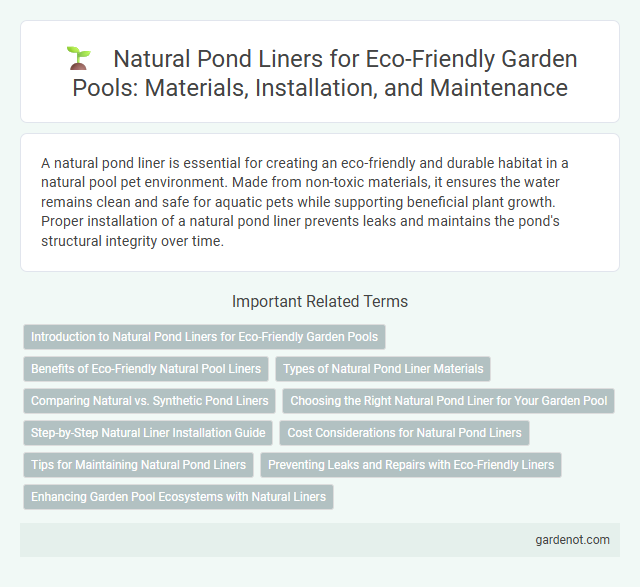A natural pond liner is essential for creating an eco-friendly and durable habitat in a natural pool pet environment. Made from non-toxic materials, it ensures the water remains clean and safe for aquatic pets while supporting beneficial plant growth. Proper installation of a natural pond liner prevents leaks and maintains the pond's structural integrity over time.
Introduction to Natural Pond Liners for Eco-Friendly Garden Pools
Natural pond liners serve as an eco-friendly solution for garden pools, providing a durable, non-toxic barrier that preserves water quality while supporting local ecosystems. Made from materials like bentonite clay or biodegradable polymers, these liners prevent leakage without introducing harmful chemicals into the environment. Their seamless integration with natural landscaping enhances the sustainability and aesthetic appeal of eco-conscious water features.
Benefits of Eco-Friendly Natural Pool Liners
Eco-friendly natural pool liners offer sustainable protection by using biodegradable and non-toxic materials that minimize environmental impact. These liners enhance water quality by preventing chemical leaching and supporting natural filtration systems within the pool ecosystem. Their durable composition ensures long-lasting use while maintaining a natural aesthetic that blends seamlessly with the surrounding landscape.
Types of Natural Pond Liner Materials
Natural pond liner materials include bentonite clay, which offers excellent water retention through its swelling properties, and compacted clay, renowned for its natural impermeability and eco-friendliness. Another popular option is geomembranes made from high-density polyethylene (HDPE), known for durability and chemical resistance, although less natural. Combining natural liners like bentonite with organic materials such as sand or gravel enhances structural integrity and environmental compatibility in natural pool construction.
Comparing Natural vs. Synthetic Pond Liners
Natural pond liners, often made from clay or bentonite, provide an eco-friendly and non-toxic barrier that supports natural water filtration and aquatic life sustainability. Synthetic pond liners, typically crafted from materials like EPDM or PVC, offer superior durability and flexibility but may leach chemicals over time, affecting water quality. Choosing between natural and synthetic liners hinges on balancing environmental impact, longevity, and maintenance requirements for optimal natural pool performance.
Choosing the Right Natural Pond Liner for Your Garden Pool
Selecting the ideal natural pond liner for your garden pool involves evaluating materials like EPDM rubber, bentonite clay, and natural clay, each offering unique benefits in durability, flexibility, and environmental impact. EPDM rubber liners provide long-lasting resilience and are UV resistant, ideal for varying weather conditions, while bentonite clay liners create an impermeable seal through natural swelling for eco-friendly water retention. Consider soil composition, pool size, and maintenance needs to ensure optimal water quality and longevity of your natural pool ecosystem.
Step-by-Step Natural Liner Installation Guide
Installing a natural pond liner involves clearing the pond area of debris and sharp objects before laying a protective underlayment to prevent punctures. Carefully place the natural liner over the prepared base, ensuring it extends beyond the pond edges, then smooth out wrinkles while maintaining the liner's flexibility to accommodate water movement. Secure the edges by burying them in a trench or anchoring with stones, followed by gradually filling the pond with water to allow the liner to settle evenly.
Cost Considerations for Natural Pond Liners
Natural pond liners vary in cost depending on the material, with high-density polyethylene (HDPE) and reinforced PVC being more affordable options, while rubber-based EPDM liners tend to have higher initial expenses but offer greater durability. Installation costs also impact the overall budget, as professional labor or complex pond shapes increase expenses. Long-term maintenance savings from natural pond liners with UV resistance and puncture protection can offset upfront costs, making them a cost-effective choice for sustainable natural pools.
Tips for Maintaining Natural Pond Liners
Maintaining natural pond liners requires regular inspection for tears or punctures to prevent leaks and ensure water retention. Using gentle cleaning methods like soft brushes and avoiding harsh chemicals helps preserve the liner's integrity and supports a healthy aquatic environment. Applying a protective layer of gravel or aquatic plants can shield the liner from UV damage and physical wear, extending its lifespan.
Preventing Leaks and Repairs with Eco-Friendly Liners
Natural pond liners made from eco-friendly materials such as bentonite clay or recycled rubber provide durable, non-toxic barriers that prevent leaks without harming aquatic ecosystems. These liners offer flexible installation and resist punctures, reducing the need for frequent repairs while maintaining water quality. Using biodegradable or recyclable pond liners supports sustainable water retention in natural pools, enhancing long-term environmental health.
Enhancing Garden Pool Ecosystems with Natural Liners
Natural pond liners made from eco-friendly materials like bentonite clay or natural rubber enhance garden pool ecosystems by maintaining water purity and supporting aquatic life. These liners prevent harmful chemicals from leaching into the water, promoting healthier environments for plants, fish, and beneficial microorganisms. Their permeability and durability ensure stable water levels and natural filtration, fostering balanced and thriving garden pools.
Natural pond liner Infographic

 gardenot.com
gardenot.com